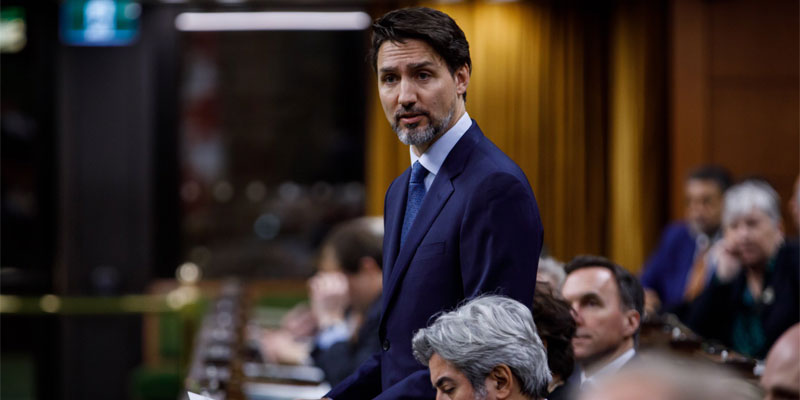Federal finances marginally improve but Trudeau government ignores risks

Finance Minister Chrystia Freeland delivered the government’s fall fiscal update, which confirms federal finances face difficulties for the foreseeable future. The update projects that the government will continue to spend well in excess of revenues, resulting in a $144.5 billion deficit this year and rising debt. The Trudeau government is showing no signs of reining in spending, creating risk and ignoring problems.
Before COVID, the Trudeau government had already been spending at record high levels, exceeding previous recessions and World Wars, even after adjusting for inflation. The update projects 2021/22 federal program spending will now reach $480.2 billion (excluding net actuarial losses), an increase of $4.6 billion since the spring budget. Federal program spending is forecasted to reach $12,825 per person, the second-highest level (inflation-adjusted) in Canadian history. For perspective, per-person spending (inflation-adjusted) was $9,536 during the Great Recession in 2009.
New spending initiatives include temporary measures to combat the Omicron COVID variant, extended income supports, and recovery money for natural disaster relief in British Columbia. However, it’s important to recall that these new measures come on top of several spending items introduced in the spring budget such as a three-year stimulus plan and a national daycare strategy. The costly programs announced in Budget 2021 illustrate that the government’s spending problem goes well beyond COVID. The initial justification for spiking federal spending during the pandemic was to temporarily support businesses and individuals during a turbulent time. Crucially, though, the government is continuing to chart a path for permanent increases given the nature of some programs.
While the fiscal update includes some positive fiscal news such as increasing federal revenues, the government is once again squandering progress toward a balanced budget. In response to this improved revenue picture, the government is planning an additional $57.5 billion in program spending between 2021/22 and 2025/26 over and above what was in Budget 2021. If Ottawa had simply planned to keep program spending at Budget 2021 levels, it could be within $7 billion of a balanced budget in 2025/26. Instead, the government is planning to spend the majority of new revenue and the 2025/26 deficit is forecasted at $22.7 billion.
The 2021/22 deficit is forecasted to total $144.5 billion, down slightly from $154.7 billion projected in the government’s spring budget due to increased revenues. Further deficits are projected over the entire forecast period which ends in 2026/27. However, the Parliamentary Budget Officer (PBO) released a recent report showing that the federal government will not balance its budget until at least 2070 unless it changes policies. In essence, the update confirms the government has no plan or intention to balance the budget any time soon.
These large, ongoing deficits are causing a substantial increase in Canada’s debt. A string of deficits leading up to 2020/21 has resulted in Canada’s debt increasing by 138.6 percent since 2007/08. However, this update projects things to get much worse. By 2026, Ottawa will have run 19 consecutive deficits and total debt will exceed $2.0 trillion. Federal debt as a share of the economy is also growing, having gone from 31.2 percent in 2019 (the last year before the pandemic) to 48.0 percent this year.
To make matters worse, the Trudeau government’s approach ignores several key risks.
Currently, Canadians are facing increasing costs for food, energy, rent, and many other essential goods. The International Monetary Fund (IMF) estimates Canada’s inflation rate will hit 3.8 per cent in 2021, which would be the 6th highest rate among 35 advanced economies. As noted in a recent study, there is a substantial risk that inflation may be longer-term rather than temporary if the Bank of Canada continues to finance the federal government’s spending.
The result is that daily life will become increasingly expensive for Canadian families.
Another concern is that interest rates are expected to rise in the coming years. All else equal, higher interest rates mean the federal government will have to spend more money on interest payments to service debt. By 2026/27, using the government’s current forecast, a one percentage point increase in the effective rate would increase annual interest costs from $40.9 billion to $50.9 billion, an increase of $10 billion. Higher debt interest costs could also bring potential downgrades in Canada’s debt rating and produce a vicious cycle of larger and larger deficits and more debt accumulation.
Finally, it’s no secret that Canada’s population is aging. As the baby boomers exit the workforce and labour participation declines, the federal government is expected to experience slower growth in revenues. An aging population will also put significant pressure on federal and provincial finances due to higher spending requirements for health care and programs such as Old Age Security. Absent a change in policy, this means Ottawa will run deficits for decades to come.
This year’s fiscal update once again re-affirmed the federal government’s proclivity for bigger government and record levels of spending, financed largely by borrowing. Unfortunately, the government ignored several serious risks and demonstrated little concern for the long-term stability of federal finances.

